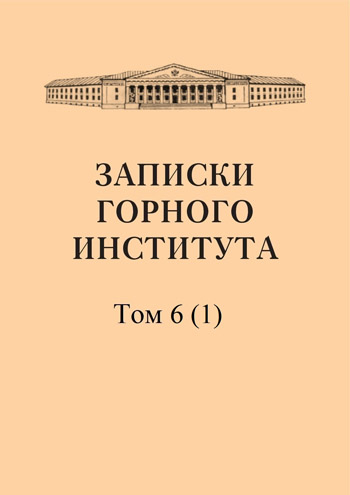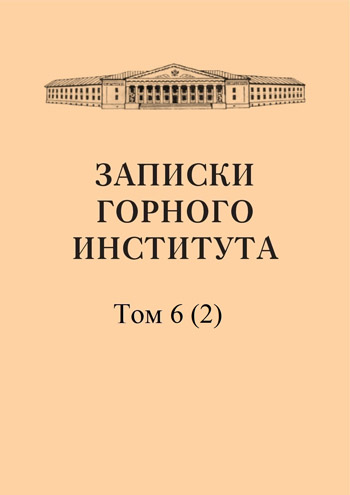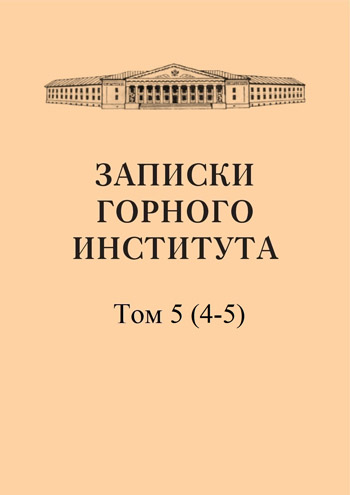-
Date submitted1916-06-25
-
Date accepted1916-08-28
-
Date published1916-12-01
Sezaro's formula and polar-zonohedral
- Authors:
- E. S. Fedorov
The author was not interested in the application of the formula for determining planes of symmetry, which is very limited, since it applies only to cases when the planes of symmetry pass through all axes of symmetry (that is, only to mirror types of symmetry, when symmetrical figures can be reproduced in gonohedral mirrors), and the formula itself with its numerical relationships. October 15, 1915. The same author and in the same journal (April 1916 p. 324) reproduces Miller's formula given in these Notes (V 233). May 4, 1916.
-
Date submitted1916-06-14
-
Date accepted1916-08-04
-
Date published1916-12-01
On the main problem in the theory of waves generated when a solid body is immersed in a liquid (ondes par emersion)
- Authors:
- N. M. Krylov
The question related is reduced, as is known in mathematical physics, to the definition of a function ϕ (x, y, t), depending on the point (x, y) and on time t, which satisfies the following conditions (see article). It is absolutely clear, as M. Vergue notes in his interesting memoir, that the expansion theorem also holds for waves occurring under the influence of impulsive forces applied on the surface of the liquid (ondes par impulsion) - the only difference is that sin is replaced by cos in the formula.
-
Date submitted1916-06-16
-
Date accepted1916-08-20
-
Date published1916-12-01
About alkaline igneous rocks
- Authors:
- N. I. Svital'skii
The author dwells on the issue of differentiation of primary planetary magma (see article). In addition to the factors that acted and determined magmatic differentiation during the period of cooling of the planet and its solidification, other factors subsequently acted that continued the work of their predecessors. Such factors must be recognized as water and the atmosphere after their appearance on earth. These figures continued to differentiate the rocks, separating bases and acids and concentrating them at individual points, for example, depositing thick layers of limestones, quartz sandstones, alkali chlorides and other compounds. These concentrated bases and acids, absorbed again by the magma, may have been the reason for the violation of homogeneity and excessive enrichment in bases, which led to the appearance of basic rocks, both alkaline and alkaline earth. Standing on this point of view, we can, based on a single primary, for example, granite magma, explain all the diversity of magmas that gave rise to the emergence of igneous rocks on the earth's surface, with which we are gradually becoming acquainted.
-
Date submitted1916-06-06
-
Date accepted1916-08-28
-
Date published1916-12-01
A note on the Taylor series remainder
- Authors:
- N. M. Krylov
To solve the question of whether the remainder Rn of the Taylor series tends to zerowhen lim n = ∞, they try, as is known, to present the remainder in various forms, because often for this one form is more convenient than the other, as can be seen for example. at least in the log (1 + x) expansion. This method can obviously be generalized to find various forms of the remainder of interpolation formulas.
-
Date submitted1916-06-28
-
Date accepted1916-08-04
-
Date published1916-12-01
Wedge microscopic preparations of the simplest device
- Authors:
- E. S. Fedorov
The purpose of these preparations is to make it possible, in all cases where laboratory crystals are obtained from supersaturated solutions, to carry out an optical study in parallel with the goniometric one with the most accurate possible orientation of the axes of the optical ellipsoid. Until recent years, I used homemade preparations, composing them from scraps of cover slips, cut and glued onto a slide so as to create the required wedge space for crystallization. Now I have settled on a relatively simple and very convenient type for research, which is quite clear from the attached plan and section of a microscopic specimen (see article).
-
Date submitted1916-06-14
-
Date accepted1916-08-16
-
Date published1916-12-01
On the remainder of the Lagrange interpolation formula
- Authors:
- N. M. Krylov
In view of the simplicity of analytical tools for proof and the absence of the need to study a large literature on the issue, the problem of finding various forms of the remainder of the Lagrange and Newton interpolation formulas could be of particular interest to those starting mathematical research for the first time; It is therefore offered to these individuals as a topic for independent work, not of a compilative nature.
-
Date submitted1916-06-02
-
Date accepted1916-08-26
-
Date published1916-12-01
The triplicity of the installation of trigonaloid crystals
- Authors:
- E. S. Fedorov
I mean to limit myself only to the simpler conclusions that I use in lectures (see article). From this triplicity we deduce the need for restrictions on the main numbers of the symbol of the complex, that is, that for an octahedral structure one cannot accept a number greater than 63 1/2°, for a hexahedral one one can accept only numbers within 45° - 63 1/2°, and for dodecahedral only numbers greater than 45°.
-
Date submitted1916-06-17
-
Date accepted1916-08-28
-
Date published1916-12-01
A new example of a special structural isomorphism
- Authors:
- E. S. Fedorov
These few examples (see article) provide extremely important indications of the dependence of crystallization on the arrangement of atoms in particles of complex structure. In such particles, therefore, it is necessary to distinguish between the central and peripheral parts (in simple particles, for example ClNa, this is impossible) and only the latter, by the density of the arrangement of atoms, determines the position of possible faces.
-
Date submitted1916-06-03
-
Date accepted1916-08-24
-
Date published1916-12-01
About the variational methods of Ritz and Boussinesq
- Authors:
- N. M. Krylov
Для индивидуального определения коэффициентов полученного уравнения (см. статью) полученное выражение тождественно с тем, которое получается примененим метода Kitz’a, а потому, в силу результата нашей выше цитированной статьи, можем утверждать, что процесс Boussinesq'a в рассматриваемом частность случай дает точное решение задачи. В общем случай вопрос остается открытым, хотя некоторые соображения заставляют предполагать, что рассмотренный выше частный случай не будет единственным случаем „сходимости" процесса Boussinesq’a.
-
Date submitted1916-06-20
-
Date accepted1916-08-03
-
Date published1916-12-01
Symbol of a plane passing through three atoms
- Authors:
- E. S. Fedorov
According to the essence of the basic law of crystal chemistry, the position of each individual atom is expressed in coordinates (see article), where both numerators and denominators are integers, and, moreover, the denominators are certainly numbers greater than the numerators if the points are located inside an elementary parallelohedron or on its surface. Using the results, we can easily directly obtain the symbol of the edge passing through them using the symbols of three points.
-
Date submitted1916-06-30
-
Date accepted1916-08-14
-
Date published1916-12-01
On some inequalities established when presenting the Schwartz-Poincare - Steklov method and also encountered in solving many minimal problems
- Authors:
- N. M. Krylov
In various mathematical studies related to the question of the existence of a minimum, it is often useful, as we will try to show below, the application of that basic relationship in the theory of trigonometric series, which was named by Prof. V. A. Steklov as a closed equation and generalized by him for many other systems of orthogonal functions found in analysis and mathematical physics.
-
Date submitted1916-06-15
-
Date accepted1916-08-29
-
Date published1916-12-01
On the question of determining work during rolling
- Authors:
- S. N. Petrov
To check to what extent the calculations using the formulas I derived in previous notes are consistent with the experimental results, I, but on the instructions of Prof. I. A. Thieme applied these formulas to the data of experiments carried out on the rolling of sheet iron at the Schulz, Knaudt, etc. plant. C° in Essen. These data are presented in the article by Prof. Thieme: “Indicative experiments on rolling steel rails and beams” (Mining Journal, 1883) and in the article by E. Blass: “Zur Theorie des Walzprocesses” (Stahl u. Eisen, 1882, No. 7).
-
Date submitted1916-06-12
-
Date accepted1916-08-07
-
Date published1916-12-01
On the convergence of formulas for mechanical quadratures and some related issues
- Authors:
- N. M. Krylov
T. J. Stieltjes was one of the first mathematicians who posed from a very general point of view the question of the convergence of formulas of the so-called mechanical quadratures. Recently, a very simple and elegant proof of Stieltjes' result for the case of continuous functions was given by J. V. Uspenskii, who uses Weierstrass's main theorem regarding the approximation of continuous functions using polynomials. However, in view of the importance of the question and some of the consequences that follow from this, it seems not uninteresting, in our opinion, to interpret the question without the help of the above-mentioned Weierstrass theorem and without a preliminary study, a quite complex one, which will be the subject of the first paragraph of this work.
-
Date submitted1916-06-29
-
Date accepted1916-08-18
-
Date published1916-12-01
On singular Abelian functions
- Authors:
- N. V. Lipin
The following proposals are the results of my research related to the theory of Abelian integrals and functions with reducible periods.
-
Date submitted1916-06-18
-
Date accepted1916-08-03
-
Date published1916-12-01
On correspondences between points of two Riemann surfaces (Note I)
- Authors:
- N. V. Lipin
The principle of correspondence between two points of Riemann surfaces can be considered as a new form of the reduction problem, allowing the use of transcendental research methods. I will indicate only the most important results that I managed to obtain in this direction.
-
Date submitted1916-06-11
-
Date accepted1916-08-09
-
Date published1916-12-01
Petrographic note about the Mount Vysokaya
- Authors:
- D. D. Nikitin
In the summer of 1910, participating as a lecturer in the compilation of a geological map of the Mount Vysokaya (the work was carried out by Professor V. V. Nikitin at the invitation of the Board of the Nizhnii-Tagil Plants), I compiled a collection of rocks. This may be of interest for elucidating the composition of the constituent rocks, as well as the genesis of the origin of this large deposit of magnetic iron ore.
-
Date submitted1916-06-16
-
Date accepted1916-08-15
-
Date published1916-12-01
A theorem similar to Pascal's theorem, but related to space
- Authors:
- E. S. Fedorov
Since on the plane a similar problem is solved very simply on the basis of Pascal’s theorem, it is very natural that the thought of geometers was persistently directed towards finding a simple solution to the problem for space, and failure raised this question to the level of a difficult problem. Pascal's theorem can be formulated in various ways, but, especially from the point of view of modern rheometry, for which it served as one of the first foundations, this formulation must be associated with collineation, namely one that transforms the conoprime defined by five points into itself. The construction according to a theorem similar to Pascal's is transferred to all geometric systems, in particular, to the system of planes, but the last theorem, as a theorem of a non-positional nature, is transferred only to related systems, and for example, it is not transferred to a system of planes, just as for a system of rays on plane, the non-positional theorem just given is not applicable.
-
Date submitted1916-06-03
-
Date accepted1916-08-15
-
Date published1916-12-01
Some corollaries from a theorem similar to Pascal's theorem
- Authors:
- E. S. Fedorov
Let us turn to similar constructions in space, which are a consequence of a theorem similar to Pascal’s theorem. Since the basis of the construction according to this theorem is the structure of two hyperboloids of a linear prime, to which the desired conosecond belongs, and for this it is necessary to construct two hexaprimes, it is clear that the data can be such tangents together with the points of tangency on them, which are sufficient for the construction of hexaprimes. To understand why Pascal’s theorem, and therefore its analogues, has fundamental significance, it is enough to point out that these theorems are only partial expressions of the deepest and most important fundamental theorem of new geometry, according to which in two projective systems linear collections correspond to linear, quadratic, quadratic, in general, aggregates of the n-th order are aggregates of the same order. In this case, intersections correspond to intersections, tangents to tangents, and involutions to involution.
-
Date submitted1916-06-16
-
Date accepted1916-08-20
-
Date published1916-12-01
An important step in scientific petrography
- Authors:
- E. S. Fedorov
(Regarding Bowen's book The later stages of the evolution of the igneous rocks). The author of this note has long distinguished between normal igneous rocks with more or less strict signs of chemical equilibrium and anomalous ones, not amenable to any laws of equilibrium and any strict scientific classification, but bearing bright signs of the sequential course of the phenomenon, which, thanks to them, can be clarified in its sequence. Such rocks can only be described, and historical and geological dates can be deduced from the inventories. Now, after the publication of Bowen’s important work, one is involuntarily inclined to think about a very weak representation of normal breeds and, perhaps, even their absence; In nature, only approximations to them are presented, which is why we have to look at them not as normal, but as ideal.
-
Date submitted1916-06-21
-
Date accepted1916-08-30
-
Date published1916-12-01
Criterion for the correct construction of the main parallelohedron of a crystal according to experimental data
- Authors:
- E. S. Fedorov
In the article “Results of the first stage of an experimental study of the structure of crystals” (in the note on page 361) the principle of determining the structure from a parallelohedron of the smallest volume is established, which is equivalent to the principle of establishing a system of parallelohedrons of the highest order permissible for a given regular system of points. A criterion for the correct construction of a parallelohedron can be a test of the possibility of another, more special, arrangement of one of the atoms represented in the chemical formula in the smallest number, or, even better, if there are no single atoms, the placement of that special point that occupies a single position in the parallelohedron.
-
Date submitted1916-06-26
-
Date accepted1916-08-28
-
Date published1916-12-01
On the issue of uralitization
- Authors:
- E. S. Fedorov
- V. N. Lodochnikov
Первое, что следует из сделанных наблюдений, это несомненная связь образования актинолита с разложением плагиоклаза. Ведь эта связь до того неразрывна, что, как упомянуто, авгит решительно нигде не прикасается к плагиоклазовым псевдоморфозам. Нам, конечно, неизвестна ближайшая первая причина разложения плагиоклаза и авгита и конечно, она сводится к остающемуся нам неизвестным содержанию составных частей проникавшего в породу минерализованного раствора, в состав которого, однако, должны были входить как СаО (от разложения плагиоклаза), так и К2О (иначе не образовалось бы мусковита), и при этом первая часть диффундировала из плагиоклаза, а вторая по направлению к нему. А так как в местах выхода диффундировавших частей из очертаний плагиоклаза мы видим превращение авгита в актинолит, и так как именно СаО есть единственная, исходящая из плагиоклаза, составная часть, содержание которой в актинолите больше, чем в авгите, то приходится заключить, что именно она и останавливалась и поглощалась авгитом, также задетым общим химическим изменением породы, более резким в плагиоклазе, чем в авгите.
-
Date submitted1916-06-08
-
Date accepted1916-08-21
-
Date published1916-12-01
Regarding one of Korkin-Zolotarev problems
- Authors:
- Ya. Shokhat
Korkin and Zolotarev establish that the required polynomials have n roots in the interval (‒1, +1) and derive a series of equations that these roots satisfy; from the analysis of these equations they deduce the uniqueness of the solution to the problem. This note offers a simpler proof of the uniqueness of the solution, requiring knowledge only of the number of roots of the required polynomials in the interval (‒1, +1). The method of evidence can be successfully used in many similar issues of a more general nature.


